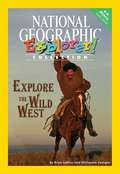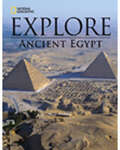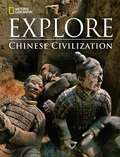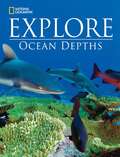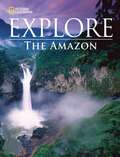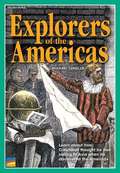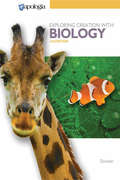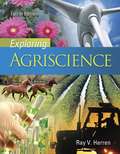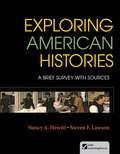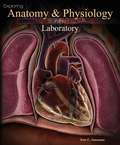- Table View
- List View
Explore: Antarctica (National Geographic Explore Series)
by National Geographic LearningNIMAC-sourced textbook
Explore: Chinese Civilization (National Geographic Explore Series)
by National Geographic LearningNIMAC-sourced textbook
Explore: Invitations to Literacy
by Mary Ellen Vogt Marjorie Y. Lipson Kathryn H. Au Jacqueline C. Comas Margarita Calderon J. Sabrina Mims Susan E. Page Sheila W. ValenciaIn this edition of Houghton Mifflin's Explore: Invitations to Literacy, students can explore a lot of interesting and useful reading treasures.
Explorer T.H. Culhane: Energy Solutions (Science 4 #Book Five)
by Lara Phelan Glen Culhane T. H. WinegarNIMAC-sourced textbook
Explorer Zoltan Takacs: Snake Venom (Science 6 #Book One)
by National Geographic LearningNIMAC-sourced textbook
Explorers of the Americas
by Margaret Mcnamara Michael SandlerPerform this script about an ancient Maya love story. (Set of 12 with Teacher's Guide)
Explorers on the Move (Fountas & Pinnell Classroom, Guided Reading)
by Stephen Krensky Pete SmithNIMAC-sourced textbook. Fearless Frank and Hotfoot Harry are brave explorers traveling through dangerous places. Or are they two boys going home for a hot lunch?
Exploring Creation with Biology
by Vicki DincherAs scientific studies advance farther out into the universe as well as deeper into the microscopic world, scientists continue to ask, “What is life?” Biology is the study of life, and this 3rd edition of Exploring Creation with Biology teaches not only the science of how we begin to answer the bigger questions defining life, but also includes meaningful discussions on Creation and Creator. <p><p> This updated high school biology course was redesigned to help students see and understand the beauty of life that surrounds us. Full-page infographics were created to help students grasp the concepts discussed in the text and go beyond simple illustrations. <p> As a college-prep high school biology course, it will set the stage for success in homeschooled high school years, prepare students for college level courses, and give them an understanding of the basic biological world that surrounds them each day of their lives so that they can appreciate the real-world relevance of scientific inquiry. <p> Opening with the studies of the process of science, students learn about observations and inferences, hypotheses, experiments, and scientific theories and laws. They are taught to see the limitations of science and learn about the tools used in biological studies. <p> In their studies of life, students will delve into the chemistry of life from atoms to the chemical structures that make life, as we know it, possible. They will explore the ecology that surrounds life as they investigate ecosystems, biomes, populations, and communities. <p> An in-depth study of cell structure and function, cellular energy, DNA, proteins, and cell cycles will help students comprehend heartier materials as they advance to learn about genetics – inheritance, disorders, and technology, as well as the role of genetics in evolution. <p> Students will also learn about prokaryotes, viruses, protists, and fungi. They will delve deep into the fascinating world of plants and animals. And all of their learned knowledge will be backed by hands-on experimentation that takes their book knowledge and applies it to concepts that they can comprehend. <p> At Apologia, we believe that students’ educations should prepare them for life, not just an academic year. This creation-based science course will create the strong foundation students can rely upon as they grow in their awe and wonder of our world. <p> At the completion of this course, students will be able to understand the vocabulary of biology so that they can engage in true scientific discourse. Their strong background in the scientific method regarding experimentation, field studies, microscopy, and dissection will also allow them to be well equipped to analyze data that they will encounter throughout their lifetimes.
Exploring America, Part 1 (Columbus to Reconstruction)
by Ray NotgrassThis curriculum will guide you through the story of our country from the first European explorers to the present. We place great emphasis on original documents and speeches because these allow the participants in history to tell the story from their own perspective. This curriculum also introduces some of the great literature that Americans have produced: novels, short stories, autobiographies, memoirs, essays, poems, hymns, and other kinds of writing. The written and spoken word has a profound ability to move hearts and minds. This course also explores the significance of faith with regard to history. Faith is connected with history in two ways. First, people have often been motivated to act because of their faith in God. For instance, faith motivated the Pilgrims on the Mayflower to seek a new land in which to live. Faith caused people to oppose slavery. Faith has been expressed often in the speeches and documents that Americans have produced. We recognize and highlight the importance of faith throughout the American story. A second way that faith should be connected to history is by looking at the overall story of American history through the eyes of faith. We encourage students to think about the faith lessons that they can learn from people and events in history. For instance, many God-fearing Americans owned slaves and had a strong prejudice against blacks. We need to understand what caused those Christian people to be blinded by their culture and how they missed the example of Jesus and the teaching of Scripture about this issue (see John 4:7-9, Galatians 3:28, and Ephesians 2:19). This might help us realize cultural blindnesses we suffer today. A study of history can inform, challenge, and strengthen our own faith. "
Exploring America, Part 2 (Late 1800's to Present)
by Ray NotgrassThis curriculum will guide you through the story of our country from the first European explorers to the present. We place great emphasis on original documents and speeches because these allow the participants in history to tell the story from their own perspective. This curriculum also introduces some of the great literature that Americans have produced: novels, short stories, autobiographies, memoirs, essays, poems, hymns, and other kinds of writing. The written and spoken word has a profound ability to move hearts and minds. This course also explores the significance of faith with regard to history. Faith is connected with history in two ways. First, people have often been motivated to act because of their faith in God. For instance, faith motivated the Pilgrims on the Mayflower to seek a new land in which to live. Faith caused people to oppose slavery. Faith has been expressed often in the speeches and documents that Americans have produced. We recognize and highlight the importance of faith throughout the American story. A second way that faith should be connected to history is by looking at the overall story of American history through the eyes of faith. We encourage students to think about the faith lessons that they can learn from people and events in history. For instance, many God-fearing Americans owned slaves and had a strong prejudice against blacks. We need to understand what caused those Christian people to be blinded by their culture and how they missed the example of Jesus and the teaching of Scripture about this issue (see John 4:7-9, Galatians 3:28, and Ephesians 2:19). This might help us realize cultural blindnesses we suffer today. A study of history can inform, challenge, and strengthen our own faith. "
Exploring American Citizenship
by Globe FearonThe Student Texts and Student Workbooks provide helpful charts, tables, and maps that allow students to look closely at all critical aspects of U.S. government, including citizenship, the justice system, foreign policy, and much more. The book helps students understand the development of the government and the rights and laws of local, state, and federal governments.
Exploring American Histories: A Brief Survey with Sources
by Steven F. Lawson Nancy A. HewittThis book written in an innovative format makes broad and diverse American history accessible to students and instructors interested in a more active learning and teaching style.
Exploring American Histories: A Survey with Sources (American Histories #1)
by Steven F. Lawson Nancy A. HewittOur book offers a new kind of U.S. history survey text, one that makes a broad and diverse American history accessible to a new generation of students and instructors interested in a more engaged learning and teaching style. To accomplish this, we carefully weave an unprecedented number of written and visual primary sources, representing a rich assortment of American perspectives, into each chapter.
Exploring American History
by John O'ConnorIn this book you will read the story of your country from its beginnings to the present day. The people who tell this story are called historians. You may wonder how historians find out what happened in the past. Historians are like detectives. They use many kinds of clues to learn about the way people lived and what they did in years gone by.
Exploring Anatomy & Physiology in the Laboratory
by Erin C. AmermanMany years ago, when I first started teaching anatomy and physiology, my biggest frustration with the course came from the laboratory. It seemed as if I were pulling teeth to get my students interested in the lab material and most students were unable to make the connections between lecture and lab.
